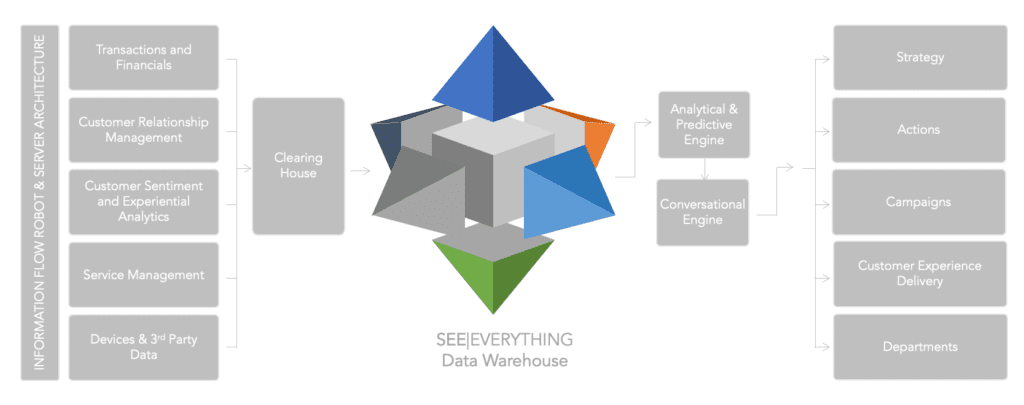EXPERIENCE ENCANVAS IN 60-MINUTES!
We're always happy to walk you through Encanvas no matter where you are in the world.

Customer Data Integration (CDI) is the process of consolidating and then properly managing information about your customers from all available business sources, including all known contact details, financial data associated with that client, and information gathered through marketing activities.
Encanvas Customer Data Platform (CDP) incorporates advanced tooling for Customer Data Integration (CDI) as standard.

Most businesses want to maximize their customer experience by leveraging data. To achieve that requires the formation of an aggregated data-mart to present a single version of the truth. Preventing this ambition is the incumbent approach to data management, forged over the years as departments have invested in software to support discrete processes. Companies will use a blend of software applications and third-party tools along with their core enterprise resource planning system to fulfil their processes. This results in a fragmented and unregulated environment for data.
As businesses face an ever more regulated operating environment and greater competition in their local markets owing to the impact of Internet and mobile phone use, executives can ill afford to ignore the importance of installing appropriate controls over how customer and financial data is used, who uses it and how they use it.
An important business driver for integration services comes from the desire of executives to harvest data from across their enterprise in order to make informed decisions. The drive towards a data-driven culture demands that systems connect to one another. The integrity of data executives review, is a major sticking point.
A survey of 442 business executives around the world by Harvard Business Review found that corporate decision makers have major concerns about access to, availability of, and the quality of internal and outside data. The result is reduced confidence in their decision-making ability.
Moreover, nearly half of the global respondents said their lack of confidence stems from a lack of information or easy access to data. The findings are puzzling given the emergence of big data techniques, the proliferation of global networks and the sheer processing power contained even in mobile devices.
One reason for the disconnect between big data and decision making, the Harvard researchers found, is that “silos of data, typically imprisoned in customer, financial, or production systems, are frequently inaccessible by individuals outside the functional group.”
In this regard:
There are a series of discrete activities that need to be performed in order to bring customer data together from where it exists:
Not all data is accurate and complete all of the time. Take accounting information for example. Sometimes, invoicing lags behind sales. Taking a read of data at the wrong time in the accounting calendar can return unhelpful and potentially destructive information! It’s very important therefore, that architects of any data harvesting project possess a deep appreciation of the business they are serving.
Data integration is difficult to get right and has many technical challenges. One of them is systems latency. Sometimes, unless sessions are maintained, connections to third-party systems can drop.
Encanvas is an enterprise software company that specializes in helping businesses to create above and beyond customer experiences.
From Low Code to Codeless
Better than code-lite and low-code, we created the first no code (codeless) enteprise application platform to release creative minds from the torture of having to code or script applications.
Use Encanvas in your software development lifecycle to remove the barrier between IT and the business. Coding and scripting is the biggest reason why software development has been traditionally unpredictable, costly and unable to produce best-fit software results. Encanvas uniquely automates coding and scripting. Our live wireframing approach means that business analysts can create the apps you need in workshops, working across the desk with users and stakeholders.
When it comes to creating apps to create a data culture and orchestrate your business model, there’s no simpler way to instal and operate your enterprise software platform than AppFabric. Every application you create on AppFabric adds yet more data to your single-version-of-the-truth data insights. That’s because, we’ve designed AppFabric to create awesome enterprise apps that use a common data management substrate, so you can architect and implement an enterprise master data management plan.
Encanvas supplies a private-cloud Customer Data Platform that equips businesses with the means to harvest their customer and commercial data from all sources, cleanse and organize it, and provide tooling to leverage its fullest value in a secure, regulated way. We provide a retrofittable solution that bridges across existing data repositories and cleanses and organizes data to present a useful data source. Then it goes on to make data available 24×7 in a regulated way to authorized internal stakeholders and third parties to ensure adherence to data protection and FCA regulatory standards.
Encanvas Secure and Live (‘Secure&Live’) is a High-Productivity application Platform-as-a-Service. It’s an enterprise applications software platform that equips businesses with the tools they need to design, deploy applications at low cost. It achieves this by removing coding and scripting tasks and the overheads of programming applications. Unlike its rivals, Encanvas Secure&Live is completely codeless (not just Low-Code), so it removes the barriers between IT and the business. Today, you just need to know that it’s the fastest (and safest) way to design, deploy and operate enterprise applications.
Learn more by visiting www.encanvas.com.
Ian Tomlin is a management consultant and strategist specializing in helping organizational leadership teams to grow by telling their story, designing and orchestrating their business models, and making conversation with customers and communities. He serves on the management team of Encanvas and works as a virtual CMO and board adviser for tech companies in Europe, America, and Canada. He can be contacted via his LinkedIn profile or follow him on Twitter.
CIO article on Customer Data Integration
Blog article on CDI
Wikipedia article on data integration